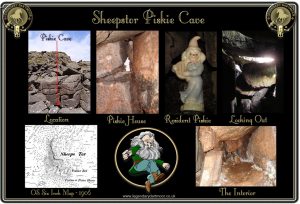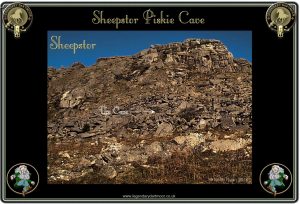
“Whom the untaught Shepherds call
Pixies in their madrigal,
Fancy’s children, here we dwell:
Welcome, Ladies! to our cell.
Here the wren of softest note
Builds its nest and warbles well;
Here the blackbird strains his throat;
Welcome, Ladies! to our cell.”
Samuel Taylor Coleridge – Songs of the Pixies.
High up amongst the craggy granite outcrops of Sheepstor lies a small, naturally formed cave that sits amongst a dense scatter of rocks and boulders. The cave goes by several names; Piskie’s Cave, Piskie’s Hole, Piskie’s Grott, Piskie’s House, and Elford’s Cave, but whatever one calls it, the place has for centuries been shrouded in mystery and superstition. From the various names one can easily assume that the cave was/is a dwelling place for the little folk of the moor. Even today there is a certain air of mystery to the Piskie’s Cave as it can be hard to find, especially if the mist or rain is down.
As with many of these ‘curiosities’ the Piskie’s Cave became a feature of interest to those in search of the picturesque or romantic during the 1800s. As the cave is difficult to find some local folk cashed in on the legend by offering their services by guiding the curious to its location. On the 21st of September of 1883 The Exeter Gazette carried a feature on the parish of Sheepstor in which it said; “Years ago it attracted many visitors to this romantic spot, but even in those days strangers were warned to procure the services of a guide, as the entrance was not easily discoverable… one fissure on the north side of the tor was many times mistaken for the entrance to this singular retreat… A noise of dripping water, the cause of which is out of site, and therefore at first occasions a feeling of surprise, may have possibly occasioned the belief as to the cavern being the resort of invisible beings.”
Most of the early Dartmoor topographical writers had visited the cave and have bequeathed to us their legacy of lasting impressions. One of the earliest written records of the Piskie’s Cave was that penned by the Reverend Polwhele in 1797 in his book – ‘The History of Devonshire’. This was closely followed 39 years later by Mrs Bray’s account of her determined visit to the cave: “With a little boy for our guide we again ascended the mountain. Leaving our horses below, we followed our conductor over some rugged rocks, till he came to one in which was a narrow fissure. On telling us this was the entrance, we laughed, and said none but the pixies and himself could enter it; but, on assuring us it was the spot, I resolved to make the attempt. With great difficulty I succeeded, and found a hollow about six feet long, four wide and five high. It was formed by two rocks resting in a slanting position against another in a perpendicular direction. The cavity was certainly singularly regular and had somewhat the form of a little hovel. A rock served for a seat and the posture of sitting was the only on in which I could find myself at ease. A noise occasioned by the dripping of water is distinctly heard; and as the cause of it is out of sight, it produces at first a sensation somewhat approaching to surprise, till reflection tells us the occasion of it: which might possibly have prepared the mind to imagine it the resort of invisible beings“. – Bray, 1836, p.235.
Ten years later Rachel Evans published her recollections of the outside of the cave, it appears she lacked the adventurous spirit shown by Mrs Bray: “As the mouth of Mohammed’s cave, a spider had spun its web; the effect of the frost on this delicate fabric was most beautiful; it was a proper grating for the Pixie’s den. Not having sufficient curiosity to enter the charmed cell, cunningly guarded by a sly Arachne, we descended to the village inn, the rudest I have ever entered, and warmed ourselves by a peat fire after our ramble.” – Evans, 1846 p.106. Seven years later an anonymous author under the pen-name of Athenaeum wrote about the Piskie’s Cave and its associated folklore: “On the southern side of Sheepstor is a singular cavern, formed by large overhanging blocks of granite, called “The Pixies’ House,” within which they may be heard sometimes hammering (for they are great workers in metal), and sometimes busily pounding their cider. This cave is considered “a critical place for children;” and no one visits it without leaving a bunch of grass or one or two pins as a propitiatory offering to the mysterious beings who inhabit it.” – The Sun, November 11th, 1853. In his article of 1873, ‘The Folklore of Devonshire, R. J. King wrote the following; “They pound their cider and grind their corn; and the hum of the talk and the sound of their work may be heard by all that enter their ‘house’ among the granite masses of Sheepstor. On Sundays the faint chimes of their church bells is audible; for the pixies are great bell ringers…” p.782
It was not until 1890 that William Crossing wrote his visitor’s guide to the Dartmoor piskies, namely: ‘Tales of the Dartmoor Pixies’. In this piskie ‘bible’ he describes the cave and its location as well as issuing a dire warning to would be pilgrims insomuch as not to leave without making a tiny gift or possibly ‘offering’ to the little folk of the moor. He suggests as other earlier writers did that a pin would be a most welcomed gift or failing that a small piece of rag provided it is large enough for the piskies to make a garment,. – p.4.
However, it is not only the piskies who have occupied the small cave and by doing so added to its fame. During the Civil War, John Elford was Lord of the Manor of Longstone and a staunch Parliamentarian, despite being a member of the Long Parliament he began to question some of Cromwell’s policies. In the end he became embroiled in a plot against the Lord Protector which soon became common knowledge and resulted in a party of troops being sent to find him. Somehow Elford got to know about this and managed to scuttle off to Sheepstor where he hid in the Piskie’s Cave. Northcote, 1930, p.82. Tradition would have it that folk from Sheepstor village would take food and drink up to the tiny cave where Elford remained in exile. Mrs Bray quotes Polwhele when he says that to pass the time Elford took to cave painting: “Here, I am informed, Elford used to hide himself from the search of Cromwell’s party, to whom he was obnoxious. Hence he could command the whole country; and having some talents for painting he amused himself with that art on the walls of his cavern, which I have been told (says Mr. Yonge of Puslinch) by an elderly gentleman who had visited this place, was very fresh in his time. The country people have many superstitious notions respecting this hole“. Bray, p.235.
I must confess that I have never been to the Piskie’s Cave, it has always been a ‘tuit’ as in I must get around to it, but there is a good photograph in the Dartmoor Archive website. As far as its location, Eric Hemery describes the place: “Pixies’ Cave, right of an immense rock between summit and clitter (on the south side), is almost blocked, the slabs at its entrance having slightly shifted position in recent years.” – 1987, p.161. In 2008 I was delighted to receive some photographs of the cave showing the exact location and the inside, my thanks to Jason Adams for kindly submitting the photographs (see above). “The actual cave is exactly as Crossing describes, in size and difficulty to gain access to, but a perfect hideaway. A date from I think 1911 seems to be carved into the rock inside and it did have a few mysterious items in it, including a pixie statue and a resident bat. I have taken photo’s from the entrance towards two barns directly in front of it, the cave lies in the huge clitter of boulders quite low down on the Tor directly North from the barns as the crow flies, near a small tree amidst the rocks, the cave is sitting amidst hundreds of fallen boulders below the huge precipice of Sheeps Tor, The village church is clearly visible from the entrance. Access into the cave is a struggle but well worth the effort, and in fact there is a sister cave next door with a sign inside saying Pixie Paul’s Cave. There a few items left by others in both caves as gifts for the pixies.’
If you do decide to pay the cave a visit don’t forget to take a gift for the piskies, you wouldn’t want to wake up in the middle of the night and find that the little folk are pinching you black and blue – or even worse! Don’t take this warning too light-heartedly, there are piskies living in the cave, why else have the Ordnance Survey been marking the fact on their maps for the past 120 odd years? It has been said that on some occasions the sound of crying babies can be heard in the cave. This was put down to the fact that the piskies had a habit of stealing a human baby and replacing it with one of their kind, the ‘adopted‘ baby would then be taken to live in the cave.
Incidentally, if you are wondering what the ‘Feather Bed’ is then don’t get too excited, it’s nothing more than the summit plateau of Sheepstor, possibly so called because at one time there was a blanket bog here?

Anon .1853. English Forests and Forest Trees, Ingram, Cooke and Co., London.
Bray, A. E. 1836 A Description of the Part of Devonshire Bordering on The Tamar and the Tavy, John Murray, London.
Crossing, W. 1890 Tales of the Dartmoor Pixies, W. H. Hood, London.
Evans, R. 1846 Home Scenes: or Tavistock and its Vicinity, Simpkin & Marshall, London.
Hemery, E. 1983, High Dartmoor, Hale & Co., London.
R. J. King. 1873. Devonshire Folklore – Fraser’s Magazine, Vol. VIII. London: Spottiswoode & Co.
Northcote, R. 1930 Devon: Its Moorlands, Streams and Coasts, Chatto & Windus, London.
Polwhele, R. 1977 A History of Devonshire, Kohler & Coombes, Dorking.
 Legendary Dartmoor The many aspects past and present of Dartmoor
Legendary Dartmoor The many aspects past and present of Dartmoor



